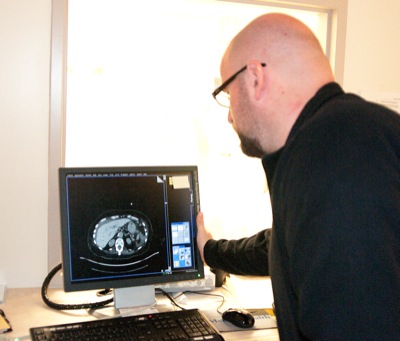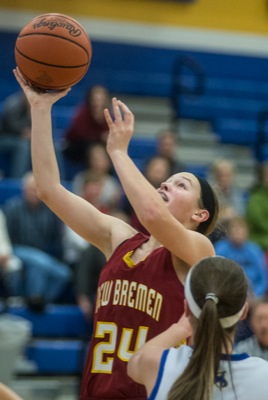Monday, January 13th, 2014
Instant information transfer quickens medical treatment
By Doug Drexler

Photo by Doug Drexler/The Daily Standard
Dr. David Hoenninger of Columbus Radiology, who specializes in interventional radiology, looks over a CAT scan at Mercer County Community Hospital, Coldwater. New technology has allowed the hospital to instantly gain expertise from a distance.
New technology gets data to doctors miles away so life-saving treatment can begin much sooner.
Telemedicine links to bigger hospitals bring specialized care that previously was unavailable to patients at smaller, rural hospitals, said Lana Hinders, director of emergency services of Joint Township District Memorial Hospital in St. Marys.
"As a small facility we have a hard time recruiting those specialties here," she said. "It's all about timeliness of care. Technology has definitely changed health care."
The changes via high-tech equipment have sped up treatment times and improved diagnoses, leading to better patient outcomes, said Cindy Liette, a clinical nurse specialist at Coldwater's Community Hospital.
"We definitely get a quicker diagnosis with technology," Liette said. "The big thing is quick access."
Decisions about care can begin while patients are en route to the hospital, they said. Paramedics can take an electrocardiogram of a patient with heart attack symptoms and transmit the results directly to the hospital where doctors can diagnose and determine if transport to a higher-level care center is needed, Liette said. The technology allows doctors to summon an emergency helicopter and have it on the way before the patient arrives at the emergency room door, she said.
Hinders said her hospital's proximity to heart centers in Lima allows doctors in St. Marys to send patients directly to the specialized facilities, bypassing Joint Township's emergency room if an electrocardiogram shows catheterization is necessary. An electronic link to the Lima hospitals means a team could be prepared to perform a catheterization within 90 minutes of the patient's arrival, she said.
Nurses in the telemonitoring home care program at Coldwater's hospital can remotely check weight and blood pressure readings of patients between doctor or nurse visits, Liette said. The nurses can detect changes early, allowing doctors to react and prevent dangerous conditions.
The technological changes are most dramatic in caring for stroke patients, both women said.
"The quicker we can do treatment, the better for the patient," Liette said. "With a heart attack we always said 'time is muscle.' With a stroke, 'time is brain.' We transfer people very quickly."
Patients with stroke symptoms bypass the emergency room and get a CAT scan en route, which can be read by specialists at the Stroke Care Now Network in Fort Wayne, Ind., Liette said. The local hospital uses an iPad computer to link up with specialists who can diagnose emergency room patients.
"It's pretty amazing what you can do with just an iPad," she said.
A 15-point test helps determine where in the brain a stroke is occurring and if it is caused by a clot or bleeding, Liette said, adding a patient's care depends on those factors. If a stroke is caused by a clot, emergency room personnel can administer clot-busting drugs before sending the patient to another facility, she said.
Through an iPad camera, specialists can watch as nurses at the local hospital perform diagnostic tests. Doctors can measure the width of a patient's pupil from a computer screen in Fort Wayne, Liette said.
"(Nurses are) his hands with the patient," she said.
Nurses operating the tests must take a four-hour training class and are required to retrain every two years, Liette said. Some of the diagnostic tests they conduct include having patients read words or identify pictures of common items, she said. Learning what to look for helps nurses identify subtle stroke symptoms that may have been missed without training, Liette added.
"It allows us to do a higher level of assessment than we did before," she said.
An earlier diagnosis also helps medical teams at bigger facilities prepare a treatment plan and get their staff ready to receive the patient, she said.
"He's (specialist) already seen the patient and has the CAT scan," Liette said. "The plan will already be in place."
Coldwater hospital activates the telemonitoring network a couple times each month, she said. The local facility always has a transport team on call, ready to care for patients being transferred to other facilities, she said.
The mobility of the iPad allows it to easily be taken throughout the hospital, Liette said. If a patient begins to show signs of a stroke, the iPad can be taken to the room to help perform a stroke analysis.
"It's very easy," she said.
Joint Township uses a robot to treat stroke patients. Stroke specialists at Ohio State's Wexner Medical Center can remotely operate the robot and zoom its camera onto any area they want to examine, Hinders said. They also can talk directly to the patient via a speaker and microphone, she said.
"This is the best thing we've ever done," Hinders said.
In the past, emergency room doctors were hesitant to administer clot-busting drugs without a stroke expert's analysis, Hinders said. Giving the drug to a patient with a bleeding stroke, instead of a clot, can be dangerous, she said.
Ohio State has a neurointerventionist on duty at all times, allowing clot-busting drugs to be administered within an hour of the patient's arrival, she added.
The increased awareness of strokes' danger has increased diagnosis and treatment at Joint Township, she said. The hospital had been initiating stroke alerts two or three times every three months in the past, she said. It now diagnoses 12 to 14 in the same time period.
The new stroke protocols mean a physician should be bedside in 15 minutes for stroke patients and lab work and a CAT scan should be done within an hour, Hinders said.
Hinders said the hospital is working to expand use of its robot such as linking it to a burn specialists at OSU, Hinders said.
Other hospital departments already use technology for real-time assistance, the women said. Columbus Radiology is tapped to read X-rays and CAT or MRI scans during hours the local departments are not staffed by a radiologist. The action can lead to a quick turnaround for testing and treatment without waiting for local staff to arrive, Liette said.
"The quicker the turnaround, the better for the patients," Liette said.
Hinders believes telemedicine will expand into areas such as pediatric specialties. Other options could link patients with family physicians via Skype or email rather than in person.
Most medical facilities already allow patients to sign in online to fill out their medical history before making doctor visits, Hinders said.
"The sky's the limit," she said.



